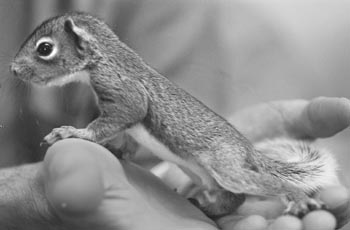![[Metroactive News&Issues]](/gifs/news468.gif)
[ San Jose | Metroactive Central | Archives ]
Call of the Wild
Silicon Valley wildlife center needs a warm touch--and cold cash--to save critters
By Kelly Wilkinson
TEN-YEAR-OLD Amanda Lewis sits on her couch, delicately feeding a syringe of milk formula to a 5-week-old baby squirrel. Her mother, Pauline, sits beside her feeding another squirming squirrel and gently instructing her daughter to tip the formula up to the animal's miniature mouth rather than down.
As volunteers for the Wildlife Center of Silicon Valley, the Lewis family has five squirrels living in a portable kennel on their piano bench, plus three baby mourning doves and one ringed-neck dove in plastic laundry baskets in the garage with screens secured over the tops.
They are part of a network of more than 100 Wildlife Center volunteers in the South Bay helping to care for injured, sick and orphaned wild animals--everything from mountain lions to baby hummingbirds. Although the center and its volunteers have been rescuing wild animals from South Bay cities for the last five years, the organization is now depending on Sunnyvale and other local cities to come to the rescue financially.
Up to this point, home volunteers and private donations have footed the bill for everything from formula to mice to mealworms. But as Debbie Champion, president of the center's board of directors, points out, animals' appetites can become pretty costly.
"Some of the raptors can eat up to $1,000 in mice each month, and some of the birds eat up to 60,000 mealworms a month," she says. "So that's become too much of a burden for our volunteers."
Born in 1993 after the Humane Society of Silicon Valley stopped taking in wild animals, the nonprofit group takes care of about 5,000 wild animals a year. Faced with budget shortfalls, the center asked the eight primary cities it serves to help meet its needs, Champion says. "If you find a wild creature in your backyard, there should be somewhere to take it. And if it takes so little to give [the animals] a second chance, we said, 'Let's see if we can get [the cities] to support us.' "
Champion says response from most of the cities has been encouraging. Of the center's $131,650 projected budget for the current fiscal year, Champion says, they hope to fund 60 percent from eight local cities. The remaining 40 percent comes from donations and membership dues.
Champion says most of the difficulty in securing the funding has come from the misperception that the Wildlife Center duplicates the Humane Society's efforts. But the Humane Society just acts as a warehousing facility, she says.
"[The cities] would think, 'Well, we don't have a wildlife problem because the Humane Society is taking care of it," she says. "But they just act as a drop-off site and then give the animals to us."
The Lewises became involved in the center after rescuing a bird from their cat's mouth last spring and being directed to the Wildlife Center, where they became aware of the need for volunteers.
"I think that the best way to teach a child to respect life is to teach them to respect plants and animals," Pauline says. "I think that it's just such a privilege to have these animals in our home. When would you ever get to have these kinds of animals around?"
All of the family is gathered in the living room, where three other wire cages form a pyramid in the center of the room. A kennel for a dog they are tending sits beside them. A rehabilitated starling chirps away in the top cage.
The Lewises take in mostly squirrels and birds, but other volunteers can be exclusively dedicated to opossums, fawns or raptors.
"People are shocked when they hear some of the teams that we have," Champion says. "They say, 'You actually have an opossum team?' But we get all kinds of animals, so we need all those different teams."
She herself became involved with the center when she bought a new house and realized that her new home may have displaced some wild animals.
"We're not an anti-development organization, but with all the development and building here in Silicon Valley, there is a substantial loss of habitat," she says. "We're trying to hold the line, but whenever you build there is a disruption in a delicate balance."
After the animals are rehabilitated, Champion says, they are released back into the wild within a three-mile radius of where they were found. The squirrels the Lewis family is watching over still have 10 more weeks to go. During that time they'll graduate from formula to fruit and walnuts and from their T-shirt-lined kennel to increasingly larger squirrel boxes and cages.
"It must be pretty traumatic for them," Pauline says. "One day, their mom has got long whiskers and a furry face, and the next day mom's got a bald face."
[ San Jose | Metroactive Central | Archives ]
Copyright © 1999 Metro Publishing Inc. Metroactive is affiliated with the Boulevards Network.
For more information about the San Jose/Silicon Valley area, visit sanjose.com.
![]()

Jeff Kearns also contributed to this report.
From the August 19-25, 1999 issue of Metro, Silicon Valley's Weekly Newspaper.